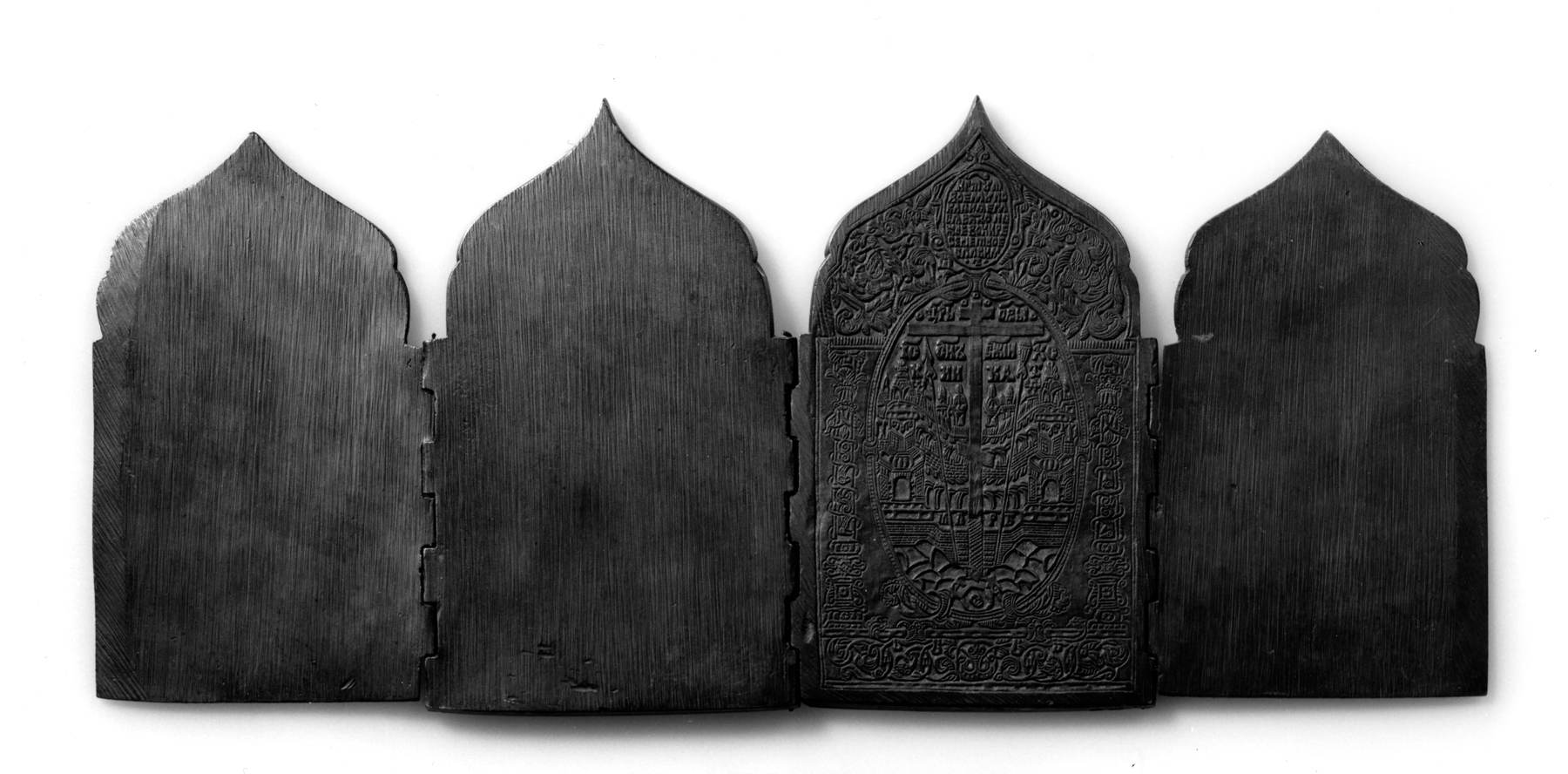Polyptych of the Feasts
(Byzantium and Early Russia)
The leaves of this icon close over each other, folding into an easily portable form. Each of the four hinged panels is topped with an ogee-shaped arch inspired by architecture, and each contains four square images in addition to the image in the arch. In the first panel, beneath the Crucifixion, are the Annunciation, Nativity of Christ, Birth of the Virgin, and Presentation of the Virgin in the Temple. The next panel has in its upper part the New Testament Trinity and the inscription "Who ascended into Heaven and is seated at the right hand of God the Father" (from the Nicene Creed). Below are the Presentation of Christ in the Temple, Baptism, Transfiguration, and Entry into Jerusalem. The third panel has the Exaltation of the Cross with Saints Constantine and Helen at the top. Below are the Resurrection, Ascension, Old Testament Trinity, and Dormition of the Virgin. The fourth panel is devoted to praise of the Virgin: at the top is the composition 'Praises to the Mother of God' (the Virgin surrounded by Old Testament prophets who have foretold the Incarnation); below are four miracle-working icons of the Mother of God flanked by saints who venerate them: the "Virgin of Belozersk" with Saints Alexander of Svir and Cyril of Belozersk, the "Virgin of Vladimir" with Saints Maximus and Basil of Moscow (both of them Fools for Christ's sake), the "Virgin of the Kievan Caves (Pecheraskaya)" with Saints Anthony and Theodosius of the Caves, and the Novgorod "Virgin of the Sign" with Saints Anthony the Roman and Leontius of Rostov. The relief figures appear against a background of blue and white champlevé enamel. On the front of the folded polyptych is a schematic depiction of the Crucifix, with a hymn to the Cross inscribed in the oval-shaped field at the top: "We venerate Thy cross, O Master, and we glorify Thy holy Resurrection" (from the Liturgy of the third Sunday of Lent). The composition of the two Crucifixion images on the icon suggests that it was made by a group of "Priestless" Old Believers (cf. Walters 54.2622).
Inscription
Provenance
Provenance (from the French provenir, 'to come from/forth') is the chronology of the ownership, custody, or location of a historical object. Learn more about provenance at the Walters.
George Way Williams, Detroit, Michigan, 1919-1920, by purchase [in Russia]; Mrs. J. Henry Dasenbrook, Baltimore, ca. 1980, by inheritance; Walters Art Museum, 1985, by gift.
Exhibitions
| 2002-2005 | Realms of Faith: Medieval and Byzantine Art from the Walters Art Museum. Frist Center for the Visual Arts, Nashville. |
| 2001-2002 | Realms of Faith: Medieval and Byzantine Art from the Walters Art Museum. Frist Center for the Visual Arts, Nashville. |
| 1996-1997 | Russian Enamels. The Walters Art Gallery, Baltimore. |
| 1988-1989 | A Millennium of Christianity: Russian Art from The Walters Art Gallery. The Walters Art Gallery, Baltimore. |
Geographies
Russia (Place of Origin)
Measurements
H: 6 13/16 x W: 15 3/4 x D: 5/16 in. (17.3 x 40 x 0.76 cm)
Credit Line
Gift of Mrs. J. Henry Dasenbrock, 1985
Location in Museum
Not on view
Accession Number
In libraries, galleries, museums, and archives, an accession number is a unique identifier assigned to each object in the collection.
In libraries, galleries, museums, and archives, an accession number is a unique identifier assigned to each object in the collection.
54.2618


